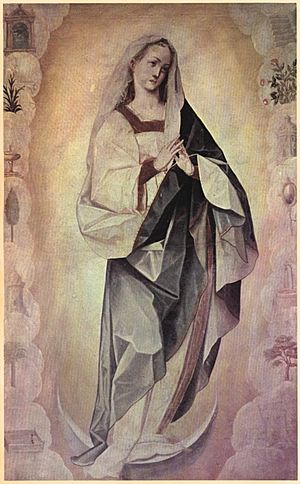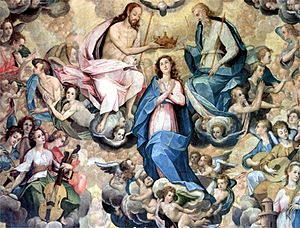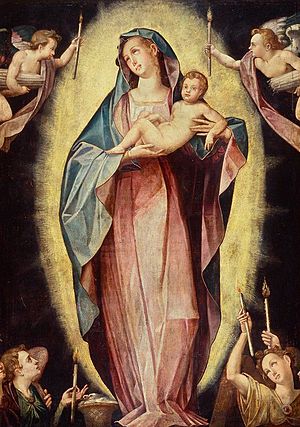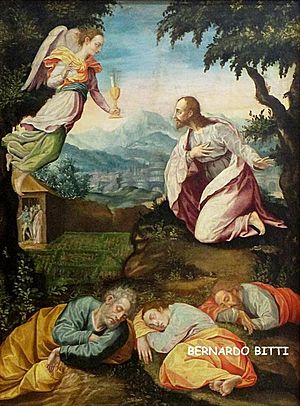Bernardo Bitti facts for kids
Quick facts for kids
Democrito Bernardo Bitti
|
|
|---|---|
| Born | 1548 Camerino, Italy
|
| Died | 1610 (aged 61–62) Lima, Viceroyalty of Peru, Spanish Empire
|
| Nationality | Italian |
| Known for | Painting |
|
Notable work
|
|
| Style | Mannerism |
Democrito Bernardo Bitti (1548–1610) was an Italian Jesuit priest and painter. He brought a special art style called Mannerism to Peru. He went there on a Jesuit mission after studying art in Rome.
On his way to Peru, Bitti traveled through Spain. There, he was inspired by Spanish painters like Luis de Morales. Bitti arrived in Peru in 1575. He began painting for churches, first in Lima and then in Cusco from 1583.
His paintings in Lima include Coronation of the Virgin and The Virgin of the Candelaria. These were made for St. Peter's Church. He often painted the Immaculate Conception. One famous example is in the Basilica of La Merced in Cusco.
Bitti's art showed the ideas of the Counter-Reformation. This was a time when the Catholic Church tried to renew itself. His art also helped teach Christian ideas to native people. After 1584, Bitti traveled all over South America, painting wherever he went.
His constant travels showed how popular he was with the Jesuits. But it also meant he couldn't set up his own art studio. He also couldn't train students. Still, his influence in South America was huge. Mannerism stayed popular there even after it went out of style in Europe. Bitti is known as the founder of the Cusco School of painting.
A Painter's Journey
Democrito Bernardo Bitti was born in Camerino, Italy, in 1548. We don't know much about his early life in Europe. He started painting when he was young. As a teenager, he moved to Rome. He studied painting there for five years. His studies focused on Italian Mannerism.
In 1568, at age 20, Bitti became a Jesuit. He moved to a Jesuit house in Rome called Sant'Andrea al Quirinale. He stayed there until 1573. He might have painted some works there, but none of them still exist today.
Meanwhile, the Jesuit mission in Peru needed skilled painters. Bitti was chosen as the best artist available. His Jesuit background made him perfect for painting altarpieces for churches. So, in 1571, Bitti was sent on a Jesuit mission to Peru. He was the first artist to travel on a Jesuit mission to South America.
His group traveled through Spain on their way to Peru. We don't know exactly what Bitti did in Spain. But he spent 14 months studying Sevillian painting. People later noticed that his paintings looked like those of Luis de Morales. Bitti probably saw Morales's works, but he didn't train with him. He was also influenced by Giuseppe Valeriano.
The Jesuit group arrived in Peru in 1575. Bitti brought the Mannerism art style to the country. He became a very popular artist. His style was new and exciting in South America. One of Bitti's first jobs was to paint for the Jesuit college and St. Peter's Church in Lima. His paintings there include Coronation of the Virgin and The Virgin of the Candelaria. Bitti also made a large altarpiece, called a retable, in St. Peter's Church. He worked in Lima for eight years.
In 1583, Bitti moved to Cusco. He stayed there until the end of 1584. In Cusco, he painted Immaculate Conception. He also built a high altar for the Jesuit church there. For the church's chapel for native people, he painted a scene of the Last Judgment. This painting is now lost. But Inca Garcilaso de la Vega wrote in 1612 that seeing it convinced many native people to convert to Christianity.
Later in his career, Bitti traveled through many places in Spanish America. These included Potosí, Arequipa, Juli, Acora, La Paz, Sucre, and Chucuito. Most of his paintings were made in Juli. Today, only his works in Peru remain. Bitti worked with other artists, like his fellow Jesuit Pedro de Vargas. They worked on art projects all over Peru. These projects included making sculptures for many altarpieces.
Bitti's Art Style

Most of Bitti's paintings show scenes from the lives of Jesus and the Virgin Mary. He painted many works about the Immaculate Conception. A famous one is in Cusco. Bitti painted for two groups of people. One group was immigrants born in Europe. The other group was newly converted native people.
He also had to make sure his art followed the rules of the Counter-Reformation. This was a time after the Council of Trent. The Church wanted art to be clear and teach religious lessons.
Bitti's art is a great example of Mannerism. His figures often have long bodies, thin arms and legs, and delicate fingers. They pose gracefully in crowded scenes. The fabric in his paintings looks crisp and "paper-like." He used bright, rich colors, often soft blues and pinks. Bitti painted with tempera paints. His style was delicate, like the artists who followed Michelangelo and Raphael. Lines were very important in his work, and his colors were cool. This shows he was similar to artists like Giorgio Vasari.
We don't have old records saying if people liked Bitti's work. But he was sent to so many places in South America, so he was probably very popular. Today, Bitti's art is seen as very well done.
His painting Coronation of the Virgin in St. Peter's Church shows the Trinity (God the Father, God the Son, and the Holy Spirit). Mary is below them. The figures have long limbs and elegant poses, typical of Mannerism. The colors are mostly soft blue and pink. Bitti experimented with colors, changing them in shadows and folds of clothing. Angels and cherubs float in the clouds. They are in many different poses, often twisting their bodies in a style called figura serpentinata.
However, this painting is different from typical Mannerism in one important way. It is very balanced and focused. This helps to highlight the Trinity. It also fits the Jesuits' goal of teaching and the spirit of the Counter-Reformation. Bitti painted the Trinity clearly. God the Father and Son look different ages. The Holy Spirit is shown as a dove. This was to avoid confusing native people. Some paintings showed the Trinity as a three-faced man or three almost identical men.
The Virgin of the Candelaria, also at St. Peter's, shows Mary holding baby Jesus. Angels light the scene with candles. The dramatic light in this painting is common in Bitti's work. He probably learned this style during his time in Spain.
Immaculate Conception, an altarpiece in the Basilica of La Merced in Cusco, is a typical Bitti painting. Mary has sharp features. She is set against a background that doesn't show a specific place. This painting was made for prayer. It makes Mary seem both reachable to the worshipper and from another world. The colors are cool and pastel. The fabric folds in his usual stiff way.
Agony in the Garden was painted around 1600. It is now in the Lima Art Museum. It shows a long, graceful figure of Christ and an angel. Both wear pastel clothes that seem to float, ignoring gravity and their body shapes.
His Lasting Impact
Bitti returned to Lima and worked there until he died in 1610. When he passed away, Bitti was a highly respected artist. He is known as the founder of the Cusco School of painting. Many other Italian painters came to South America after him. These included Matteo Pérez and Angelino Medoro, who arrived the same year as Bitti. But few became as important as Bitti. His influence on painting in Peru during the time of the Viceroyalty was very strong.
Bitti never stayed in one place long enough to open a workshop or teach students. But his art still influenced many painters in the Andes mountains. This was especially true in Cusco and the Audiencia of Charcas in Bolivia. Gregorio Gamarra is the only artist known to have been a true follower of Bitti. Lázaro Pardo de Lagos, Diego Cusi Guamán, and Pedro Bedón also showed his influence. Through Bedón, Bitti also influenced the Quito School of art. Many paintings in Peruvian churches and monasteries that are not yet identified also show Bitti's style. Because Bitti was so influential, Mannerism continued to be popular in Peruvian and Bolivian art. This happened even after the style was no longer fashionable in Europe.
See also
 In Spanish: Bernardo Bitti para niños
In Spanish: Bernardo Bitti para niños
- Peruvian art




